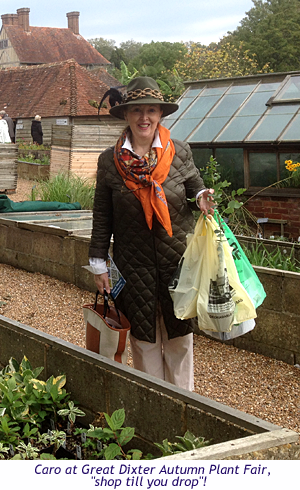|
 I have always loved Hemerocallis, more commonly known as Daylilies. My parents had a five acre garden where they grew quite a few Hemerocallis - but of course, back in the 1950s and 60s, there were far fewer varieties available. As a child I remember great swathes of them growing at the back of the herbaceous borders, along with Hostas, irises, roses, lilies, Peonies, lavender, nepeta, lupins and all the traditional perennials I still love today. I have always loved Hemerocallis, more commonly known as Daylilies. My parents had a five acre garden where they grew quite a few Hemerocallis - but of course, back in the 1950s and 60s, there were far fewer varieties available. As a child I remember great swathes of them growing at the back of the herbaceous borders, along with Hostas, irises, roses, lilies, Peonies, lavender, nepeta, lupins and all the traditional perennials I still love today.
 The National Collection of Historic Hemerocallis (Brummitt, Coe and Randall cvs. 1959- 1979) were quickly established in beds by the south facing wall of the garden. Elsewhere, a further fifty more-modern varieties I have collected since the 1970s, have been placed in the herbaceous borders, demonstrating how well Hemerocallis can combine with other plants. The National Collection of Historic Hemerocallis (Brummitt, Coe and Randall cvs. 1959- 1979) were quickly established in beds by the south facing wall of the garden. Elsewhere, a further fifty more-modern varieties I have collected since the 1970s, have been placed in the herbaceous borders, demonstrating how well Hemerocallis can combine with other plants.
 They all thrive in the walled garden and, by annual division, their numbers increase year upon year. Soaring summer temperatures present some challenges, not least drought and pests such as Gall Midge, which would not normally have bothered these mid to late season bloomers. Now however, they are blooming earlier and we need to be vigilant for any signs of pests and diseases. Luckily, since we dead-head every day we can keep a close eye on any deformities. They all thrive in the walled garden and, by annual division, their numbers increase year upon year. Soaring summer temperatures present some challenges, not least drought and pests such as Gall Midge, which would not normally have bothered these mid to late season bloomers. Now however, they are blooming earlier and we need to be vigilant for any signs of pests and diseases. Luckily, since we dead-head every day we can keep a close eye on any deformities.
 As National Collection holders we are not restricted by hosepipe bans during drought but we do prefer to harvest and save rainwater and to act responsibly with a view to supporting the natural environment. It has been interesting to see how well the plants respond to far less water and the intense heat, not to mention the milder, wetter winters. As National Collection holders we are not restricted by hosepipe bans during drought but we do prefer to harvest and save rainwater and to act responsibly with a view to supporting the natural environment. It has been interesting to see how well the plants respond to far less water and the intense heat, not to mention the milder, wetter winters.
 Hemerocallis are real show-stoppers when all in bloom and they are amazingly tolerant of the vagaries of the English climate. Over the past few years, plants from the Collection have been short-listed at RHS. Hampton Court Palace Show as Rare and "Threatened in Cultivation" by Plant Heritage. Hemerocallis are real show-stoppers when all in bloom and they are amazingly tolerant of the vagaries of the English climate. Over the past few years, plants from the Collection have been short-listed at RHS. Hampton Court Palace Show as Rare and "Threatened in Cultivation" by Plant Heritage.
 Situated in the lovely Clun Valley, within the Welsh Marches, on the border of Herefordshire, Shropshire and Powys, we enjoy welcoming visitors from all over the world, who come to see not only the Hemerocallis but the long herbaceous borders, cutting beds of award-winning Dahlias, the Historic walled garden and enjoy a good, old-fashioned English tea and cakes. The gardens are open for various charities and through the Historic Houses Association every summer but we are delighted to welcome groups by appointment. Situated in the lovely Clun Valley, within the Welsh Marches, on the border of Herefordshire, Shropshire and Powys, we enjoy welcoming visitors from all over the world, who come to see not only the Hemerocallis but the long herbaceous borders, cutting beds of award-winning Dahlias, the Historic walled garden and enjoy a good, old-fashioned English tea and cakes. The gardens are open for various charities and through the Historic Houses Association every summer but we are delighted to welcome groups by appointment.
 Caro Skyrme MA., FRSA. Is a Committee Member of the British Hosta and Hemerocallis Society. She writes regularly for The Irish Garden Plant Society and other Horticultural Journals. Caro Skyrme MA., FRSA. Is a Committee Member of the British Hosta and Hemerocallis Society. She writes regularly for The Irish Garden Plant Society and other Horticultural Journals.
Broadward Hall Gardens Webpage at: https://www.broadwardhallgardens.co.uk
Follow us on Instagram at: https://www.instagram.com/broadwardhallgardens
Email contact: Caro Skyrme at: broadwardhallgardens@gmail.com
|


